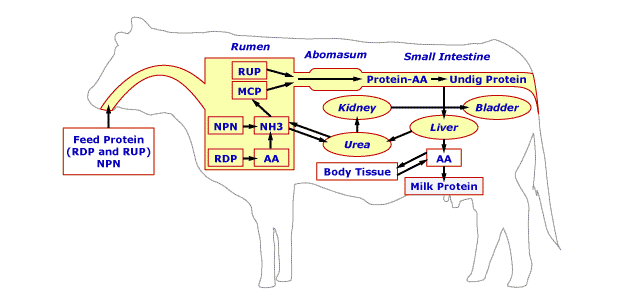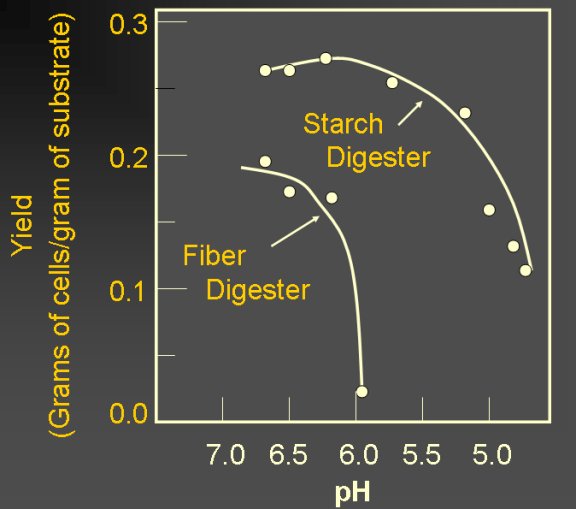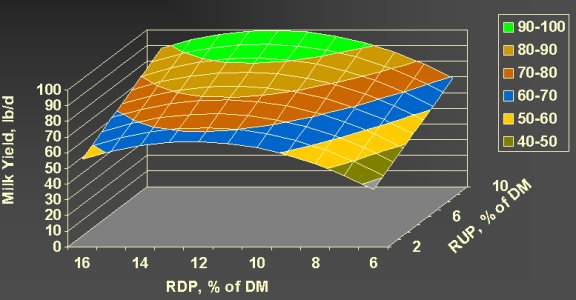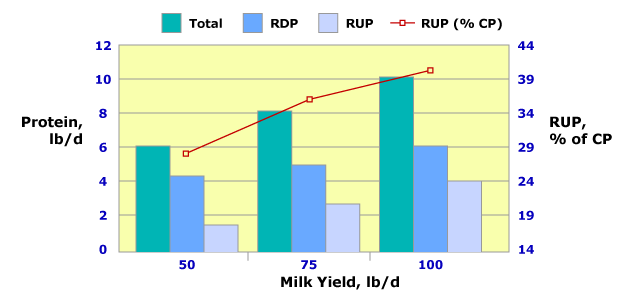Previous Page | Right click this page to print.
Protein
Moving on to protein. The maintenance requirements for a lactating dairy cow, is about a pound of protein per day just to replenish protein that is lost. Growth, of course, will increase protein requirement in the first and second lactation. For milk yield, cows need about .008 of a pound of protein per pound of milk. For reproduction, actually the last two months of gestation, a cow needs an extra two pounds protein per day to make fetal requirements. For weight gain, a cow needs about .3 of a pound of protein per pound of weight gain. This chart of protein requirements for a cow producing 65 pounds of milk, she is pregnant and growing and gaining weight it is actually very similar to the energy graph.

About 51% of the intake goes to other states rather than milk production.
That means about 49% of the protein is left over for milk production.
Protein metabolism and digestion is pretty complicated in ruminant animals.

Cows can consume intact feed proteins or non-protein nitrogen and a good example of this would be urea. Once in the rumen, protein has two fates. Urea, or non-protein nitrogen, is immediately converted to ammonia or NH3. Intact feed proteins have one of two fates. Either they are degraded in the rumen, and this in abbreviated as rumen degradable protein or RDP. Protein that is degraded in the rumen, is first degraded to amino acids. Then the microbes hydrolyze the ammonia from the amino acid and in turn they use the NH3 to produce more microbial protein. Some feed in the rumen is not degraded and passes to the small intestine and is degraded similar to monogastrics there. Also, the microbes are continually flowing out of the rumen and microbes are quite high in protein, about 80% and they are about 80% digestible in the small intestine. They are also a good source of amino acids. Excess ammonia in the rumen actually flows across the rumen wall and is converted to urea. And in some situations, if urea is limiting in the rumen, it flows back out of the bloodstream, back into the rumen and is used by the microbes. Some excess urea is excreted in the urine. But eventually what happens in the small intestine is that the feed, the undegraded feed proteins, and the microbes are digested in the small intestine and eventually goe to the mammary gland to produce milk protein. The two protein fractions described in the last picture are rumen degradable protein or RDP. RDP is degraded to ammonia by microbes in the rumen and usually protein is not limiting in the rumen. Microbial growth actually depends upon the amount of carbohydrates fermented in the rumen. Microbial crude protein production, in grams per day, can be predicted by a very simple equation, .13 times the kilos of TDN digested in the rumen. If rumen available protein is not limiting, microbial production depends upon how many kilos or grams or pounds of TDN that is digested in the rumen. Many times we will actually add a soluble protein. Soluble proteins are proteins that are converted to ammonia very quickly in the rumen. It is common to find about .2 to .3 of a pound of urea in dairy diets. However, urea or ammonia can be toxic to the animal. It should never exceed .4 of a pound per head per day. The other protein fraction is rumen undegradable protein. This is protein that is not degraded in the rumen and it simply passes to the small intestine where it is digested.
pH can have a significant impact on the yield of microbes in the rumen.

On the X-axis is the pH, ranging from a neutral seven to somewhat acidic
five. Along the Y-axis it is the yield, grams of cells per grams of substrate.
You will notice a significant drop off in yield of fiber digesting bacteria
when the pH reaches somewhere around six. Fiber digesting bacteria prefer
a relatively neutral pH. When you get somewhere between five and a half
and six, the yield of starch digesters declines, but not as rapidly as
fiber digesters. The highest yield occurs at a pH greater than six and
a half. The goal should be to achieve a somewhat neutral pH in the rumen
to maximize growth of all types of microbes.
There has been quite a bit of work done in the response of feeding different
levels of rumen degradable protein to cows and different levels of rumen
undegradable protein. This is a response surface graph to different supplementation
rates.

The green depicts cows giving 90 to 100 pounds of milk, the tan 80 to
90 pounds of milk, the red 70 to 80, the blue 60 to 70 pounds of milk,
the yellow 50 to 60 and we have one slight green section of 40 to 50 pounds
of milk. If you look at the X-axis first, rumen degradable protein ranges
from 16% to 6% and we can that this is curvilinear effect. At very high
levels of rumen degradable protein, milk production declines. And at very
low levels of rumen degradable protein milk production declines. At very
low levels, it is simple to explain in that, there simply was not enough
ammonia in the rumen to supply the requirements of the microbes. At very
high levels, we usually shorted the animal on rumen undegradable protein
so milk production declined. So really, regardless of milk production
level, the optimal level of rumen degradable protein, as a percent of
dry matter, is about 12%. As for rumen undegradable protein, the effect
was actually linear. As rumen undegradable protein the effect was actually
linear. As rumen undegradable protein increased from 2% to 10%, milk yield
increased linearly. However, it is very unrealistic to feed a cow 22%
protein. I rounded this number by adding 12% rumen degradable protein
plus 10% rumen undegradable, so the total ration dry matter would be 22%
protein. It is very uncommon that we would formulate diets greater than
18% protein. That means rumen degradable protein should be set at about
12% of dry matter and rumen undegradable protein at 6% so this would be
a maximum of 18% of crude protein in the diet dry matter. This graph depicts
different protein fractions based upon milk yield.

We can see cows producing 50 pounds of milk need about 6 pounds of protein
per day and some of this is degradable and some is undegradable. So the
bars, or the axis for the bars, would be the left axis. The red line is
rumen undegradable protein, as a percent of crude protein, and this would
be the right Y-axis. We can see as milk production increases from about
50 pounds, cows need about 29% of the protein as rumen undegradable, up
to cows producing 100 pounds, they need about 39% of the protein as undegradable
protein. As milk yield increases, generally, we increase rumen undegradable
protein in the diet of these cows.
If we look at some common protein supplements in the US, we have brewer’s,
canola, cottonseed meal, distiller’s and soybean meal.
CP (% DM) |
Soluble (% CP) |
RDP (% CP) |
RUP (% CP) |
|
|---|---|---|---|---|
Brewers |
30 |
4 |
34 |
66 |
Canola |
40 |
32 |
63 |
37 |
CS Meal |
46 |
20 |
57 |
43 |
Distillers |
30 |
6 |
26 |
74 |
48% SBM |
55 |
20 |
65 |
35 |
These are all high protein supplements. An easy way that we can predict degradability or undegradability is to look at the solubility of a feed. First look at brewer’s. Solubility means protein that is soluble in the liquid, so what would soluble in the rumen when the cow consumes it. Compared to the other feedstuffs, degradable protein is relatively low and undegradable is relatively high. We look at some feedstuffs with relatively high degradability, these would be canola, cottonseed meal and soybean meal and you can see that all of these have a high solubility. Another good undegradable source would be distiller’s, which about 6% soluble and 74% undegradable.
There are other sources that are actually very high in undegradability and most of these sources are animal-derived sources, blood meal, feather meal, fish meal and Prolac, which is a combination of animal and marine products.
Source |
CP (% DM) |
RUP (% CP) |
|---|---|---|
Blood Meal |
93 |
75 |
CG Meal |
67 |
59 |
Feather Meal |
86 |
70 |
Fish Meal |
67 |
65 |
Prolak |
72 |
66 |
Soy Plus |
47 |
55 |
The two non-animal products are corn gluten meal and Soy Plus. Some
of these products, such as Soy Plus, have been protected or the undegradability
increased through processing. The other products are just naturally high
in undegradable protein.
Previous Page | Right click this page to print.